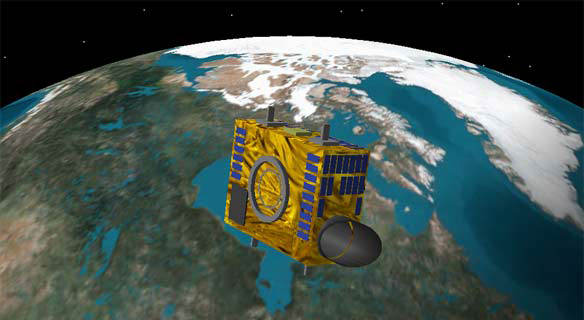Early next week, an Indian rocket will launch into space carrying seven satellites on board. Among them will be a small but mighty asteroid-hunting telescope called NEOSSat. Built by the Canadian Space Agency, it will mainly focus on the Atira class of asteroids, which are made up of space rocks within Earth’s orbit, to figure out their size and distribution. The suitcase-sized NEOSSat will orbit approximately 800 kilometers above Earth, searching for near-Earth asteroids that are difficult to spot using ground-based telescopes.
Here’s a full rundown of what’s soaring to space on Monday (Feb. 25), if all goes to plan. Check out the launch from India at this link; it’s supposed to go into space around 7:25 a.m. Eastern (12:25 p.m. UTC).
– NEOSSat (Canada). Short for Near-Earth Object Surveillance Satellite, the satellite is actually split into two different missions. For half the time, it will be keeping a sharp eye out for asteroids that may swing by Earth at some point. The telescope will spend its other science mission watching satellites and space debris in orbit, to better track their movements.
“NEOSSat will discover many asteroids much faster than can be done from the ground alone,” said Alan Hildebrand of the University of Calgary. “Its most exciting result, however, will probably be discovering new targets for exploration by both manned and unmanned space missions.”
– SARAL (India/France). This is by far the largest satellite of the fleet; the rest of the mini sats listed below are hitching a ride to share launch costs. The satellite is supposed to take altimeter measurements of water and ice to watch the movement of waves and to add more data into climate change databases, among other objectives.
– CanX-3 BRITE (Canada). The BRIght Target Explorer is billed as the smallest astronomical telescope, at just 8 inches (20 centimeters) across. Unlike bigger observatories that focus on very faint objects, BRITE will — as the name suggests — watch over brighter stars that we commonly use on Earth to connect the dots in constellations. Oddly enough, despite their prominence in our sky, these brighter stars are poorly studied, astronomers said.
– Sapphire (Canada). A military mission, this satellite will keep track of objects orbiting between 3,800 and 25,000 miles (6,000 and 40,000 kilometers) from Earth. The Canadians will share this information with their close military ally, the Americans.
– TUGSat-1 BRITE (Austria). This will be the first Austrian satellite. Like CanX-3, it will investigate bright stars by watching the changes in brightness using a technique called photometry (measuring visible light.) The satellite is equipped with a high-resolution CCD imager to take pictures.
– AAUSat 3 (Denmark). This satellite will test the capabilities of automatic identification of ships (AIS) technology, following the beacons that ships are required to send out with information about their cargo and destination. Most of the testing will focus on the water around Greenland.
– STRaND-1 (United Kingdom). This satellite is literally a screamer, as it will be broadcasting the sound of human screams into space to see if anyone nearby can hear them. (This is to test the oft-repeated phrase that in space, nobody can hear you scream.) Besides monitoring shrieks, the satellite makers will be testing how well the satellite is controlled by a smartphone. The acronym is short for Surrey Training, Research and Nanosatellite Demonstrator.


This all reminds me of this novel I just read called THE MYOSHI EFFECT, which is about how people react when a giant asteroid heads toward earth. The discussions on how to stop it and so forth, straight from the novel – which is a humor novel but based on science – which makes it funnier to me. Fiction becomes fact. Strange times we live in.